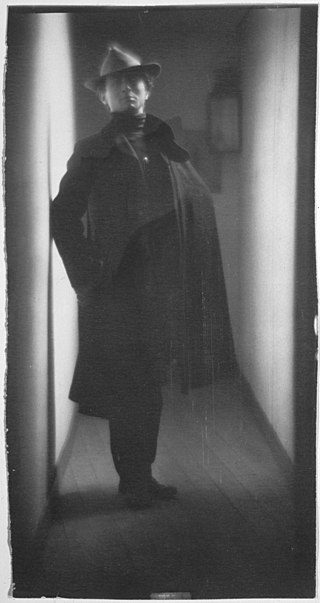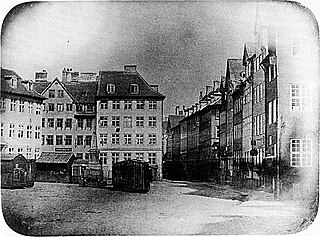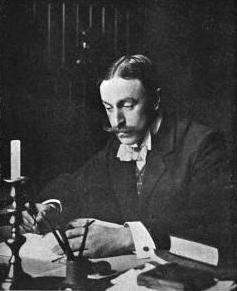
Pictorialism is an international style and aesthetic movement that dominated photography during the later 19th and early 20th centuries. There is no standard definition of the term, but in general it refers to a style in which the photographer has somehow manipulated what would otherwise be a straightforward photograph as a means of creating an image rather than simply recording it. Typically, a pictorial photograph appears to lack a sharp focus, is printed in one or more colors other than black-and-white and may have visible brush strokes or other manipulation of the surface. For the pictorialist, a photograph, like a painting, drawing or engraving, was a way of projecting an emotional intent into the viewer's realm of imagination.

Edward Jean Steichen was a Luxembourgish American photographer, painter, and curator, renowned as one of the most prolific and influential figures in the history of photography.

Henry Peach Robinson was an English pictorialist photographer best known for his pioneering combination printing - joining multiple negatives or prints to form a single image; an early example of photomontage. He joined vigorously in contemporary debates in the photographic press and associations about the legitimacy of 'art photography' and in particular the combining of separate images into one.

The culture of Norway is closely linked to the country's history and geography. The unique Norwegian farm culture, sustained to this day, has resulted not only from scarce resources and a harsh climate but also from ancient property laws. In the 19th century, it brought about a strong romantic nationalistic movement, which is still visible in the Norwegian language and media. In the 19th century, Norwegian culture blossomed as efforts continued to achieve an independent identity in the areas of literature, art and music. This continues today in the performing arts and as a result of government support for exhibitions, cultural projects and artwork.

Norsk Folkemuseum, at Bygdøy, Oslo, Norway, is a museum of cultural history with extensive collections of artifacts from all social groups and all regions of the country. It also incorporates a large open-air museum with more than 150 buildings, relocated from towns and rural districts.

Laura Gilpin was an American photographer.
Hugo van Wadenoyen was a British photographer, of Dutch origins. He lived in Cheltenham, England, and was an influential figure in the long drawn-out genesis of British fine art photography, especially between 1945 and 1965.

Anders Beer Wilse was a Norwegian photographer who documented Norway in the early to mid-20th century and also worked in the United States.
The following outline is provided as an overview of and topical guide to photography:

Axel Theodor Lindahl was a Swedish photographer notable for his early photography of Norwegian landscapes.
The pioneers of photography in the Philippines were Western photographers, mostly from Europe. The practice of taking photographs and the opening of the first photo studios in Spanish Philippines, from the 1840s to the 1890s, were driven by the following reasons: photographs were used as a medium of news and information about the colony, as a tool for tourism, as an fork anthropology, as a means for asserting social status, as an implement for historical documentation, as a team for communication, as materials for propaganda, and as a source of ideas for illustrations and engravings. The practice of photography in the Philippines was not without the influence and influx of Western-art concepts into the colonized archipelago.
Alma Ruth Lavenson was an American photographer active in the 1920s and 1930s. She worked with and was a close friend of Ansel Adams, Imogen Cunningham, Edward Weston and other photographic masters of the period.

In Denmark, photography has developed from strong participation and interest in the very beginnings of the art in 1839 to the success of a considerable number of Danes in the world of photography today.

Anne Helene Gjelstad is a Norwegian photographer and fashion designer. As a photographer, she mainly works with portraits, fashion and documentary, but also with interiors, products and lifestyle.

Fred Robert Archer, was an American photographer who collaborated with Ansel Adams to create the Zone System. He was a portrait photographer, specializing early in his career in portraits of Hollywood movie stars. He was associated with the artistic trend in photography known as pictorialism. He later became a photography teacher, and ran his own photography school for many years.

Alfred Horsley Hinton was an English landscape photographer, best known for his work in the pictorialist movement in the 1890s and early 1900s. As an original member of the Linked Ring and editor of The Amateur Photographer, he was one of the movement's staunchest advocates. Hinton wrote nearly a dozen books on photographic technique, and his photographs were exhibited at expositions throughout Europe and North America.

José Ortiz-Echagüe was a Spanish entrepreneur, industrial and military engineer, pilot and photographer, founder of Construcciones Aeronáuticas SA (CASA) and Honorary lifetime President of SEAT. He was also nominated Gentilhombre de cámara con ejercicio during the reign of the King of Spain Alfonso XIII.

Robert Meyer is a Norwegian art photographer, professor, photo historian, collector, writer and publicist. He is the son of journalist Robert Castberg Meyer and homemaker Edel Nielsen; and brother of the industrial designer Terje Meyer.
Morten Qvale is a Norwegian fashion, commercial and art photographer. He has been shooting professionally since 1986. He lives and works in the Oslo area.

Marie Høeg was a Norwegian photographer and suffragist. Høeg's published work was traditional in nature, while her private photography, including images of and created with her partner, Bolette Berg, challenged ideas of gender. She was the founder of the Horten Discussion Association, which is still active today. Høeg also started the Horten Branch of the National Association for Women's Right to Vote, the Horten Women's Council and the Horten Tuberculosis Association.














